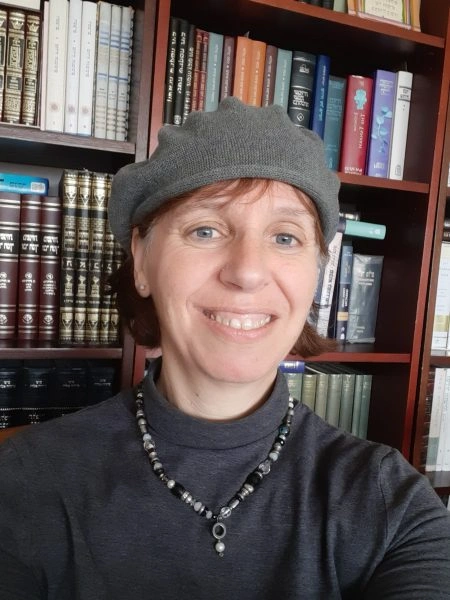האם בהמות יכולות לצאת עם דברים שמשתמשים בהם לנוי לבהמה? המשנה מדברת על טהרתן של כלים אלו שעל הבהמה. אבל האם כלים אלו ראויים לקבל טומאה – הרי רק כלים שמיודעים לאדם מקבלים טומאה! איך אפשר לטהרם על ידי טבילת הבהמה במים, הרי יש חציצה כי הדבר תלוי בצואר הבהמה והמים לא יכולים להגיע סביב כל הכלי? ר’ אליעזר מספר לתלמיד שכל הטבעות וכל המחטים שווים לעניין טומאה. הגמרא מביאה קושיות על דברים אלו ממקורות תנאיים.
רוצה להקדיש לימוד?
חדשה בלימוד הגמרא?
זה הדף הראשון שלך? איזו התרגשות עצומה! יש לנו בדיוק את התכנים והכלים שיעזרו לך לעשות את הצעדים הראשונים ללמידה בקצב וברמה שלך, כך תוכלי להרגיש בנוח גם בתוך הסוגיות המורכבות ומאתגרות.
פסיפס הלומדות שלנו
גלי את קהילת הלומדות שלנו, מגוון נשים, רקעים וסיפורים. כולן חלק מתנועה ומסע מרגש ועוצמתי.
שבת נב
דְּתִיתּוֹתַב דַּעְתֵּיהּ. אֲמַר לֵיהּ: חֲמוֹר שֶׁעֲסָקָיו רָעִים כְּגוֹן זֶה, מַהוּ לָצֵאת בִּפְרוּמְבְּיָא בְּשַׁבָּת? אֲמַר לֵיהּ: הָכִי אֲמַר אֲבוּךְ מִשְּׁמֵיהּ דִּשְׁמוּאֵל: הֲלָכָה כַּחֲנַנְיָא.
he will be placated and will understand that it was not my intention to disrespect him. He said to him: An undisciplined donkey whose conduct is wicked like this one that I am riding, what is the ruling with regard to having it go out with a halter on Shabbat? Typically, in order to secure a donkey, a bit suffices and it does not require a halter. A halter constitutes excessive security. However, the question is whether or not a halter that provides excessive security for a wild donkey like this one is considered a burden with which it is prohibited to go out to the public domain on Shabbat. Rabba bar Rav Huna said to him: Even if the security is considered extraneous, your father said the following in the name of Shmuel: The halakha is in accordance with the opinion of Ḥananya, who said that a device that provides excessive security is not considered a burden.
תָּנָא דְּבֵי מְנַשְּׁיָא: עֵז שֶׁחָקַק לָהּ בֵּין קַרְנֶיהָ יוֹצְאָה בְּאַפְסָר בְּשַׁבָּת. בָּעֵי רַב יוֹסֵף: תָּחַב לָהּ בִּזְקָנָהּ מַהוּ? כֵּיוָן דְּאִי מְנַתַּח לַהּ כָּאֵיב לַהּ לָא אָתְיָא לְנַתּוֹחֵהּ, אוֹ דִילְמָא זִימְנִין דְּרָפֵי וְנָפֵיל, וְאָתֵי לְאֵתוּיֵי אַרְבַּע אַמּוֹת בִּרְשׁוּת הָרַבִּים. תֵּיקוּ.
A Sage of the school of Menashiya taught a baraita: A goat in which one carved out a hole between its horns may go out with a bit on Shabbat. Because the bit is inserted through the hole, it will not become detached. Rav Yosef raised a dilemma: What is the ruling in a case where one inserted the bit through the goat’s beard? The Gemara explains the dilemma: Is the halakha that since, if the goat attempts to sever itself from the bit, it would cause it pain because the bit is attached to its beard, and therefore it will not come to sever it and the bit will remain in place? Or perhaps is the halakha that sometimes the knot will loosen and the bit will fall, and the goat’s owner will come to bring the bit and carry it four cubits in the public domain? No resolution was found to this dilemma. Let it stand unresolved.
תְּנַן הָתָם: וְלֹא בִּרְצוּעָה שֶׁבֵּין קַרְנֶיהָ. אָמַר (לֵיהּ) רַבִּי יִרְמְיָה בַּר אַבָּא: פְּלִיגִי בַּהּ רַב וּשְׁמוּאֵל. חַד אָמַר: בֵּין לְנוֹי בֵּין לְשַׁמֵּר — אָסוּר. וְחַד אָמַר: לְנוֹי — אָסוּר, וּלְשַׁמֵּר — מוּתָּר.
We learned there in a mishna: And neither may a cow go out with a strap between its horns. Rabbi Yirmeya bar Abba said: Rav and Shmuel disagreed about this: One said: Whether it was placed for beauty, as an ornament, or whether it was placed to secure the cow, it is prohibited for the cow to go out with the strap between its horns. And the other one said: For beauty, it is prohibited; however, if it was placed to secure the cow, it is permitted.
אָמַר רַב יוֹסֵף: תִּסְתַּיֵּים דִּשְׁמוּאֵל הוּא דְּאָמַר לְנוֹי אָסוּר, לְשַׁמֵּר מוּתָּר. דְּאָמַר רַב הוּנָא בַּר חִיָּיא אָמַר שְׁמוּאֵל: הֲלָכָה כַּחֲנַנְיָא.
Rav Yosef said: Conclude that Shmuel is the one who said that if the strap was placed for beauty it is prohibited; however, if it was placed to secure the cow it is permitted. As Rav Huna bar Ḥiyya said that Shmuel said: The halakha is in accordance with the opinion of Ḥananya: A device that provides excessive security is not considered a burden. Therefore, an animal may go out on Shabbat with straps that provide excessive security.
אֲמַר לֵיהּ אַבָּיֵי: אַדְּרַבָּה, תִּסְתַּיֵּים דִּשְׁמוּאֵל הוּא דְּאָמַר בֵּין לְנוֹי בֵּין לְשַׁמֵּר — אָסוּר. דְּאָמַר רַב יְהוּדָה אָמַר שְׁמוּאֵל: מַחְלִיפִין לִפְנֵי רַבִּי, שֶׁל זוֹ בְּזוֹ מַהוּ? אָמַר לְפָנָיו רַבִּי יִשְׁמָעֵאל בְּרַבִּי יוֹסֵי, כָּךְ אָמַר אַבָּא: אַרְבַּע בְּהֵמוֹת יוֹצְאוֹת בְּאַפְסָר — הַסּוּס הַפֶּרֶד וְהַגָּמָל וְהַחֲמוֹר. לָאו לְמַעוֹטֵי גָּמָל בַּחֲטָם? סָמִי הָא מִקַּמֵּי הָא.
Abaye said to him: On the contrary, conclude that Shmuel is the one who said that whether it was placed for beauty, as an ornament, or whether it was placed to secure the cow, it is prohibited. As Rav Yehuda said that Shmuel said: The students exchanged the details in the mishna before Rabbi Yehuda HaNasi and asked: What is the halakha with regard to this animal going out into the public domain with that which is permitted for that animal? And Rabbi Yishmael, son of Rabbi Yosei, said before Rabbi Yehuda HaNasi: So said father, Rabbi Yosei: Four animals may go out with a bit: The horse, the mule, and the camel, and the donkey. Does this list not come to exclude a camel going out with a nose ring, as a nose ring provides excessive security beyond that required for a camel? Apparently, according to Shmuel, an animal may not go out on Shabbat with a device that provides excessive security, as it is considered a burden. Rav Yosef said to him: Delete this latter statement of Shmuel due to that first one.
וּמַאי חֲזֵית דִּמְסַמֵּית הָא מִקַּמֵּי הָא? סָמִי הָא מִקַּמֵּי הָא! (דְּאַשְׁכְּחַן שְׁמוּאֵל הוּא דְּאָמַר לְנוֹי אָסוּר לְשַׁמֵּר מוּתָּר. דְּאִתְּמַר:) רַב חִיָּיא בַּר אָשֵׁי אָמַר רַב: בֵּין לְנוֹי בֵּין לְשַׁמֵּר — אָסוּר. וְרַב חִיָּיא בַּר אָבִין אָמַר שְׁמוּאֵל: לְנוֹי — אָסוּר, לְשַׁמֵּר — מוּתָּר.
The Gemara asks: And what did you see that led you to delete this latter statement due that first one? Delete that first statement due to this latter one. The Gemara explains: The first statement is supported as we find that Shmuel is the one who said : For beauty, it is prohibited; however, if it was placed to secure the cow, it is permitted, as it was stated that Rav Ḥiyya bar Ashi said that Rav said: Whether the strap was placed for beauty, or whether it was placed to secure the cow, it is prohibited. And Rav Ḥiyya bar Avin said that Shmuel said: For beauty, it is prohibited; however, if it was placed to secure the cow, it is permitted.
מֵיתִיבִי: קְשָׁרָהּ בְּעָלֶיהָ בְּמוֹסֵרָה — כְּשֵׁרָה. וְאִי סָלְקָא דַעְתָּךְ מַשּׂאוֹי הוּא, ״אֲשֶׁר לֹא עָלָה עָלֶיהָ עוֹל״ אָמַר רַחֲמָנָא!
The Gemara raises an objection from a baraita: If its owner tied a red heifer with its reins that are attached to the bit, it remains fit for use in the purification ritual. And if it should enter your mind to say that a bit is considered a burden, why does a red heifer remain fit for use? The Torah explicitly stated: “Speak to the children of Israel, that they bring you a red heifer without defect, in which there is no blemish, and upon which never came a yoke” (Numbers 19:2). A red heifer is disqualified by a burden.
אָמַר אַבָּיֵי: בְּמוֹלִיכָהּ מֵעִיר לָעִיר. רָבָא אָמַר: שָׁאנֵי פָּרָה דְּדָמֶיהָ יְקָרִין. רָבִינָא אָמַר: בְּמוֹרֶדֶת.
Abaye said: There, the baraita is referring to the case of a red heifer whose owner is leading it from city to city. When the animal is removed from its habitat, it requires additional security. In that case, tying the heifer with its reins is conventional rather than excessive security. Therefore, the bit is not considered a burden. Rava said: A red heifer, whose monetary value is high, is different and therefore secured more carefully than other cows. Ravina said: The baraita is referring to a red heifer that is rebellious and headstrong. Therefore, it requires added security.
הַסּוּס בְּשֵׁיר וְכוּ׳. מַאי ״יוֹצְאִין״? וּמַאי ״נִמְשָׁכִין״? אָמַר רַב הוּנָא: אוֹ יוֹצְאִין כְּרוּכִין, אוֹ נִמְשָׁכִין. וּשְׁמוּאֵל אָמַר: יוֹצְאִין נִמְשָׁכִין, וְאֵין יוֹצְאִין כְּרוּכִין.
We learned in the mishna: A horse may go out with a chain around its neck, and so too, all animals that typically have chains around their necks when they go out to the public domain may go out with chains on Shabbat and may be pulled by the chains. The Gemara asks: What is the meaning of: May go out, and what is the meaning of: May be pulled? Rav Huna said: These animals may go out either with the chain wrapped around their necks as an ornament, or they may be pulled by the chain. And Shmuel said: These animals may go out pulled by the chain; however, they may not go out with the chain wrapped around their necks as an ornament.
בְּמַתְנִיתָא תָּנָא: יוֹצְאִין כְּרוּכִין לִימָּשֵׁךְ. אָמַר רַב יוֹסֵף: חֲזֵינָא לְהוּ לְעִיגְלֵי דְּבֵי רַב הוּנָא יוֹצְאִין בְּאַפְסְרֵיהֶן כְּרוּכִין בְּשַׁבָּת.
It was taught in a baraita: They may go out with the chains loosely wrapped around their necks, so that if the need arises, the animals will be able to be pulled by their chains. Rav Yosef said: I saw the calves of the house of Rav Huna go out into the public domain on Shabbat with their bits and with the reins wrapped around their necks.
כִּי אֲתָא רַב דִּימִי אָמַר רַבִּי חֲנִינָא: מוּלָאוֹת שֶׁל בֵּית רַבִּי יוֹצְאוֹת בְּאַפְסְרֵיהֶן בְּשַׁבָּת. אִיבַּעְיָא לְהוּ: כְּרוּכִין אוֹ נִמְשָׁכִין?
When Rav Dimi came from Eretz Yisrael to Babylonia, he said that Rabbi Ḥanina said: The mules of the house of Rabbi Yehuda HaNasi go out into the public domain with their bits on Shabbat. A dilemma was raised before the Sages: Does this mean that the mules went out with their bits and reins wrapped around their necks; or, does it mean that they were pulled by the reins?
תָּא שְׁמַע, כִּי אֲתָא רַב שְׁמוּאֵל בַּר יְהוּדָה אֲמַר רַבִּי חֲנִינָא: מוּלָאוֹת שֶׁל בֵּית רַבִּי יוֹצְאוֹת בְּאַפְסְרֵיהֶן כְּרוּכִים בְּשַׁבָּת.
Come and hear a resolution to this dilemma from the following incident: When Rav Shmuel bar Yehuda came from Eretz Yisrael to Babylonia, he said that Rabbi Ḥanina said: The mules [molaot] of the house of Rabbi Yehuda HaNasi went out on Shabbat with their bits with the reins wrapped around their necks.
אַמְרוּהָ רַבָּנַן קַמֵּיהּ דְּרַב אַסִּי: הָא דְּרַב שְׁמוּאֵל בַּר יְהוּדָה לָא צְרִיכָא, מִדְּרַב דִּימִי נָפְקָא. דְּאִי סָלְקָא דַעְתָּךְ דְּרַב דִּימִי ״נִמְשָׁכִין״ קָאָמַר, מִדְּרַב יְהוּדָה אָמַר שְׁמוּאֵל נָפְקָא.
The Sages said before Rav Asi: That statement of Rav Shmuel bar Yehuda is not necessary. It may be derived from the statement of Rav Dimi. As, if it would enter your mind to say that Rav Dimi said that the mules of the house of Rabbi Yehuda HaNasi went out on Shabbat pulled by their bits, it is difficult. There is nothing novel in that statement, as it may be derived from the statement that Rav Yehuda said that Shmuel said.
דְּאָמַר רַב יְהוּדָה אָמַר שְׁמוּאֵל: מַחְלִיפִין הָיוּ לִפְנֵי רַבִּי, שֶׁל זוֹ בָּזוֹ מַהוּ? אָמַר לְפָנָיו רַבִּי יִשְׁמָעֵאל בְּרַבִּי יוֹסֵי, כָּךְ אָמַר אַבָּא: אַרְבַּע בְּהֵמוֹת יוֹצֵאת בָּאַפְסָר, הַסּוּס וְהַפֶּרֶד וְהַגָּמָל וְהַחֲמוֹר.
As Rav Yehuda said that Shmuel said: The students switched the details in the mishna before Rabbi Yehuda HaNasi, and asked: What is the halakha with regard to this animal going out into the public domain with that which is permitted for that animal? And Rabbi Yishmael, son of Rabbi Yosei, said before Rabbi Yehuda HaNasi: So said father, four animals may go out with a bit: The horse, and the mule, and the camel, and the donkey. Apparently, according to Rabbi Yehuda HaNasi, a mule may go out on Shabbat pulled by its bit.
אֲמַר לְהוּ רַב אַסִּי: אִיצְטְרִיךְ לְהוּ. דְּאִי מִדְּרַב יְהוּדָה נָפְקָא, הֲוָה אָמֵינָא: אָמַר לְפָנָיו וְלָא קַיבְּלַהּ מִינֵּיהּ. קָא מַשְׁמַע לַן דְּרַב דִּימִי.
Rav Asi said to them: This statement of Rav Shmuel bar Yehuda is necessary, as if it were derived from the statement of Rav Yehuda, who related that which Rabbi Yishmael, son of Rabbi Yosei, said before Rabbi Yehuda HaNasi, I would have said that Rabbi Yishmael, son of Rabbi Yosei, said that before him, and Rabbi Yehuda HaNasi did not accept it from him. Therefore, that statement of Rav Dimi teaches us that Rabbi Yehuda HaNasi indeed accepted it from Rabbi Yishmael and his mules went out with their bits on Shabbat.
וְאִי דְּרַב דִּימִי, הֲוָה אָמֵינָא: הָנֵי מִילֵּי נִמְשָׁכִין, אֲבָל כְּרוּכִין — לָא, קָא מַשְׁמַע לַן דְּרַב שְׁמוּאֵל בַּר רַב יְהוּדָה.
And if it had been derived only from the statement of Rav Dimi, I would have said that this applies only when the mule is pulled by its bit; however, if the reins are merely wrapped around the animal’s neck, no, the animal may not go out with it. Therefore, that statement of Rav Shmuel bar Rav Yehuda teaches us that the mules of the house of Rabbi Yehuda HaNasi went out on Shabbat with their reins wrapped around their necks.
וּמַזִּין עֲלֵיהֶן וְטוֹבְלָן בִּמְקוֹמָן. לְמֵימְרָא דִּבְנֵי קַבּוֹלֵי טוּמְאָה נִינְהוּ? וְהָתְנַן: טַבַּעַת אָדָם — טְמֵאָה, וְטַבַּעַת בְּהֵמָה וְכֵלִים וּשְׁאָר כׇּל הַטַּבָּעוֹת —
It was further taught in our mishna: If these chains contracted ritual impurity, one may sprinkle water of purification on them and immerse them in their place on the animal. The Gemara asks: Is that to say that these chains are fit to contract ritual impurity? Didn’t we learn in a mishna: A ring worn by a person is ritually impure. However, the ring of an animal, and rings of utensils, and all other rings not worn by people
טְהוֹרוֹת.
are ritually pure.
אָמַר רַבִּי יִצְחָק נַפָּחָא: בְּבָאִין מִנּוֹי אָדָם לְנוֹי בְּהֵמָה.
Rabbi Yitzḥak Nappaḥa said: Our mishna is referring to ornaments that were transformed from their original designation for a person’s adornment to an ornament designated for an animal’s adornment. They had once belonged to a person who later affixed them in order to attach a strap to an animal. Their original ritual impurity does not cease when they are attached to the animal.
וְרַב יוֹסֵף אָמַר: הוֹאִיל וְאָדָם מוֹשֵׁךְ בָּהֶם אֶת הַבְּהֵמָה. מִי לָא תַּנְיָא: מַקֵּל שֶׁל בְּהֵמָה, שֶׁל מַתֶּכֶת מְקַבֵּל טוּמְאָה. מַה טַּעַם? — הוֹאִיל וְאָדָם רוֹדָהּ בָּהֶן. הָכָא נָמֵי, הוֹאִיל וְאָדָם מוֹשֵׁךְ בָּהֶן.
And Rav Yosef said: Animals’ rings can become ritually impure since a person pulls his animal with them. Consequently, they are considered utensils used by people. Wasn’t it taught in a baraita: The metal animal prod becomes ritually impure? What is the reason that it becomes ritually impure even though it is an animal’s utensil? Since a person subjugates his animal with it, it is regarded as a utensil for use by a person; therefore, it can become ritually impure. Here too, with regard to chains, since a person pulls his animal with them, they are regarded as utensils for use by a person.
וְטוֹבְלָן בִּמְקוֹמָן: וְהָאִיכָּא חֲצִיצָה!
And we learned in our mishna: If the animals’ chains became ritually impure, one may immerse them while they are in their place on the animal, and they need not first be removed. The Gemara raises a question: Isn’t this an obstruction that renders the immersion invalid? The rings of the chain are firmly attached to the chain, and there is no room for the water of the ritual bath to completely surround the chain.
אָמַר רַבִּי אַמֵּי: בְּשֶׁרִיתְּכָן.
Rabbi Ami said: The mishna is referring to a case where he struck the rings of the chain with a hammer, widening them and thereby creating sufficient space to allow the water to surround the chain on all sides.
לֵימָא רַבִּי אַמֵּי כְּרַב יוֹסֵף סְבִירָא לֵיהּ, דְּאִי כְּרַבִּי יִצְחָק נַפָּחָא, דְּאָמַר: בְּבָאִין מִנּוֹי אָדָם לְנוֹי בְּהֵמָה — כֵּיוָן דְּרִיתְּכָן, עֲבַד בְּהוּ מַעֲשֶׂה וּפְרַחָה לַהּ טוּמְאָה מִינַּיְיהוּ.
The Gemara asks: Let us say that Rabbi Ami holds in accordance with the opinion of Rav Yosef. As, if he held in accordance with the opinion of Rabbi Yitzḥak Nappaḥa, who said that our mishna is referring to ornaments that were transformed from their original designation for a person’s adornment to an ornament designated for an animal’s adornment, and therefore they can be ritually impure with impurity contracted while it was still a person’s ornament, it is difficult. Since he struck the chain, he performed an action which altered its identity, and the impurity would have ceased even without immersion.
דִּתְנַן: כׇּל הַכֵּלִים יוֹרְדִין לִידֵי טוּמְאָתָן בְּמַחְשָׁבָה, וְאֵין עוֹלִין מִטּוּמְאָתָן אֶלָּא בְּשִׁינּוּי מַעֲשֶׂה!
As we learned in a mishna: All vessels descend into their state of ritual impurity by means of thought. Even though an unfinished vessel cannot become ritually impure, if the craftsman decided not to complete it, it immediately assumes the legal status of a completed vessel and can become ritually impure. However, they only ascend from their state of ritual impurity by means of a change resulting from an action. A ritually impure vessel, once it undergoes physical change, is no longer ritually impure. Hammering the rings is an action that effects physical change. Therefore, the chain should be ritually pure without immersion.
סָבַר לַהּ כְּרַבִּי יְהוּדָה דְּאָמַר מַעֲשֶׂה לְתַקֵּן לָאו מַעֲשֶׂה הוּא. דְּתַנְיָא, רַבִּי יְהוּדָה אוֹמֵר: לֹא אָמְרוּ שִׁינּוּי מַעֲשֶׂה לְתַקֵּן אֶלָּא לְקַלְקֵל.
The Gemara rejects this argument: Actually, Rabbi Ami could interpret the mishna just as Rabbi Yitzḥak Nappaḥa did, as he holds in accordance with the opinion of Rabbi Yehuda, who said that an action performed to enhance a utensil is not an action capable of ridding that utensil of its ritual impurity, as it was taught in a baraita: Rabbi Yehuda said: He did not say that an action that effects a physical change purifies a utensil of its ritual impurity with regard to an action performed to enhance a utensil; rather, he made his statement with regard to an action performed to ruin the utensil.
בְּמַתְנִיתָא תָּנֵי בִּמְחוּלָּלִין.
It was taught in a baraita: The mishna is referring to a case where the rings attached to the chain are well spaced so that the water completely surrounds the rings of the chain with no obstruction.
שָׁאַל תַּלְמִיד אֶחָד מִגָּלִיל הָעֶלְיוֹן אֶת רַבִּי אֱלִיעֶזֶר: שָׁמַעְתִּי שֶׁחוֹלְקִין בֵּין טַבַּעַת לְטַבַּעַת. אָמַר לוֹ: שֶׁמָּא לֹא שָׁמַעְתָּ אֶלָּא לְעִנְיַן שַׁבָּת. דְּאִי לְעִנְיַן טוּמְאָה, דָּא וְדָא חֲדָא הִיא.
It was taught in the Tosefta: A certain disciple from the Upper Galilee asked Rabbi Eliezer: I heard that one distinguishes between one type of ring and another type of ring. However, I do not know with regard to what halakha this distinction is made. Rabbi Eliezer said to him: Perhaps you only heard that distinction with regard to the matter of Shabbat; a ring for adornment may be moved on Shabbat and other rings may not. As, with regard to the matter of ritual impurity, this ring and that ring are one and the same, and there is no distinction between them.
וּלְעִנְיַן טוּמְאָה דָּא וְדָא אַחַת הִיא? וְהָתְנַן: טַבַּעַת אָדָם טְמֵאָה, וְטַבַּעַת בְּהֵמָה וְכֵלִים וּשְׁאָר כׇּל הַטַּבָּעוֹת טְהוֹרוֹת! כִּי קָאָמַר לֵיהּ אִיהוּ, נָמֵי דְּאָדָם קָאָמַר לֵיהּ.
The Gemara raises an objection: And with regard to the matter of ritual impurity, are this and that one and the same? Didn’t we learn in a mishna: A ring worn by a person is ritually impure; however, the ring of an animal, and that of utensils, and all other rings not worn by people are ritually pure? Apparently, a distinction is made between different types of rings with regard to the halakhot of ritual impurity as well. The Gemara answers: When Rabbi Eliezer was saying that statement to the disciple, he too was saying to him that with regard to ritual impurity there is no distinction between different types of rings worn by a person.
וּדְאָדָם, דָּא וְדָא אַחַת הִיא? וְהָתַנְיָא: טַבַּעַת שֶׁהִתְקִינָה לַחְגּוֹר בָּהּ מׇתְנָיו וּלְקַשֵּׁר בָּהּ בֵּין כְּתֵפָיו — טְהוֹרָה, וְלֹא אָמְרוּ טְמֵאָה אֶלָּא שֶׁל אֶצְבַּע בִּלְבַד! כִּי קָאָמַר לֵיהּ אִיהוּ, נָמֵי דְּאֶצְבַּע קָאָמַר לֵיהּ.
The Gemara raises another objection: And with regard to rings worn by a person, are this and that one and the same? Wasn’t it taught in a baraita: A ring that one fashioned into a buckle at the end of a belt to wear it around his waist, or into a clasp to tie garments between his shoulders, is ritually pure? The Sages only said that a ring is ritually impure with regard to a ring worn on a person’s finger. Apparently, there is in fact a distinction between different rings worn by a person. The Gemara answers: When Rabbi Eliezer was saying that statement to the disciple, he too was saying to him that there is no distinction between different types of rings worn on a person’s finger.
וּדְאֶצְבַּע דָּא וְדָא אַחַת הִיא? וְהָתְנַן: טַבַּעַת שֶׁל מַתֶּכֶת וְחוֹתָמָהּ שֶׁל אַלְמוֹג — טְמֵאָה. הִיא שֶׁל אַלְמוֹג וְחוֹתָמָהּ שֶׁל מַתֶּכֶת — טְהוֹרָה! כִּי קָאָמַר לֵיהּ אִיהוּ, נָמֵי כּוּלָּהּ שֶׁל מַתֶּכֶת קָאָמַר לֵיהּ.
The Gemara raises yet another objection: And with regard to rings worn on a person’s finger, are this and that one and the same? Didn’t we learn in a mishna: A ring made of metal and its seal is made of coral, is ritually impure? The primary component of the ring, metal, is the determining factor, and a metal utensil can become ritually impure. However, a ring that is made of coral and its seal is made of metal is ritually pure. Apparently, there is a distinction between different types of finger rings with regard to ritual impurity. The Gemara answers: When Rabbi Eliezer was saying that statement to the disciple, he too was saying to him that there is no distinction between different types of rings that are made entirely of metal.
וְעוֹד שָׁאַל: שָׁמַעְתִּי שֶׁחוֹלְקִין בֵּין מַחַט לְמַחַט. אָמַר לוֹ: שֶׁמָּא לֹא שָׁמְעַתְּ אֶלָּא לְעִנְיַן שַׁבָּת, דְּאִי לְעִנְיַן טוּמְאָה דָּא וְדָא אַחַת הִיא.
And furthermore, that same disciple asked: I heard that one distinguishes between one type of needle and another type of needle. Still, I do not know with regard to what halakha this distinction is made. Rabbi Eliezer said to him: Perhaps you only heard that distinction with regard to Shabbat. With regard to the prohibition of carrying from a private to a public domain, or vice versa, there is a distinction between a needle with an eye, for which one is liable to bring a sin-offering, and one without an eye, for which one is not. As, if you were to suggest that the distinction is with regard to ritual impurity, this, a needle with an eye, and that, a needle without an eye, are one and the same, and there is no distinction between them.
וּלְעִנְיַן טוּמְאָה דָּא וְדָא אַחַת הִיא? וְהָתְנַן: מַחַט שֶׁנִּיטַּל חוֹרָהּ אוֹ עוּקְצָהּ — טְהוֹרָה! כִּי קָאָמַר לֵיהּ בִּשְׁלֵימָה.
The Gemara raises an objection: And with regard to the matter of ritual impurity, are this and that one and the same? Are all needles alike? Didn’t we learn in a mishna: A needle whose eye or whose point was removed is ritually pure, as it is no longer fit for use? Apparently, there is a distinction between an intact needle and a broken one with regard to the halakhot of ritual impurity. The Gemara answers: When Rabbi Eliezer was saying that statement to the disciple, he was referring to a whole needle. Indeed, there is no distinction between different types of whole needles with regard to the halakhot of ritual impurity.
וּבִשְׁלֵימָה דָּא וְדָא אַחַת הִיא? וְהָתְנַן: מַחַט שֶׁהֶעֶלְתָה חֲלוּדָה, אִם מְעַכֵּב אֶת הַתְּפִירָה — טְהוֹרָה, וְאִם לָאו — טְמֵאָה. וְאָמְרִי דְּבֵי רַבִּי יַנַּאי: וְהוּא שֶׁרִישּׁוּמָהּ נִיכָּר! כִּי קָאָמַר לֵיהּ, בְּשִׁיפָא קָאָמַר לֵיהּ.
The Gemara raises another objection: And with regard to whole needles, are this and that one and the same? Is there no distinction between them? Didn’t we learn in a mishna: With regard to a needle that became rusty; if the rust inhibits the sewing, the needle is ritually pure; and if it does not inhibit the sewing, it is ritually impure. And the Sages of the school of Rabbi Yannai said: And that is the halakha that the needle cannot become ritually impure not only when it is impossible to push the needle through the fabric, but even when the mark of rusty needle is conspicuous in the stitching. Apparently, there is a distinction between different types of whole needles. The Gemara answers: When Rabbi Eliezer was saying that statement to the disciple, he was saying to him that there is no distinction between different types of needles that were smoothed and filed. He was not referring to rusty needles.
וּבְשִׁיפָא דָּא וְדָא אַחַת הִיא? וְהָתַנְיָא: מַחַט בֵּין נְקוּבָה בֵּין אֵינָהּ נְקוּבָה מוּתָּר לְטַלְטְלָהּ בְּשַׁבָּת, וְלָא אָמְרִינַן נְקוּבָה אֶלָּא לְעִנְיַן טוּמְאָה בִּלְבַד!
The Gemara raises yet another objection: And with regard to smoothed needles, are this and that one and the same? Wasn’t it taught in a baraita: A needle, whether it has an eye and whether it does not have an eye, may be moved on Shabbat? And we only said that a needle with an eye is different with regard to the halakhot of ritual impurity. Apparently, there is a distinction between different types of smoothed needles with regard to the halakhot of ritual impurity.
הָא תַּרְגְּמַהּ אַבָּיֵי אַלִּיבָּא דְּרָבָא — בְּגֻלְמֵי.
The Gemara answers: Didn’t Abaye already interpret that baraita in accordance with the opinion of Rava as referring to unfinished needles? If a needle is unfinished, and it has not been perforated to create an eye, it cannot become ritually impure because it is not yet a utensil. However, if the needle is finished, whether it has an eye and is used for sewing, or it does not have an eye and is used as a pin, it is regarded as a utensil and therefore can become ritually impure.
מַתְנִי׳ חֲמוֹר יוֹצֵא בַּמַּרְדַּעַת בִּזְמַן שֶׁהִיא קְשׁוּרָה בּוֹ. זְכָרִים יוֹצְאִין לְבוּבִין. רְחֵלוֹת יוֹצְאוֹת שְׁחוּזוֹת, כְּבוּלוֹת וּכְבוּנוֹת. הָעִזִּים יוֹצְאוֹת צְרוּרוֹת. רַבִּי יוֹסֵי אוֹסֵר בְּכוּלָּן, חוּץ מִן הָרְחֵלִין הַכְּבוּנוֹת.
MISHNA: A donkey may go out on Shabbat with a saddlecloth that protects it from the cold when it is tied to the animal, and there is no room for concern lest it fall. Rams may go out levuvin. Ewes may go out sheḥuzot, kevulot, and kevunot. All of these terms are discussed and explained in the Gemara. She-goats may go out with their udders bound. Rabbi Yosei prohibits the animals from going out with all of these items, as he considers them burdens, except for the ewes that are kevunot.
רַבִּי יְהוּדָה אוֹמֵר: עִזִּים יוֹצְאוֹת צְרוּרוֹת לְיַבֵּשׁ, אֲבָל לֹא לֵחָלֵב.
Rabbi Yehuda says: Goats may go out on Shabbat with their udders bound to dry their milk supply and discontinue their lactation, in order to facilitate conception. In that case, they are tied with a tight, permanent knot, and there is no concern lest it fall in the public domain. However, they may not go out with their udders bound to conserve their milk, as in that case they are bound loosely.


















